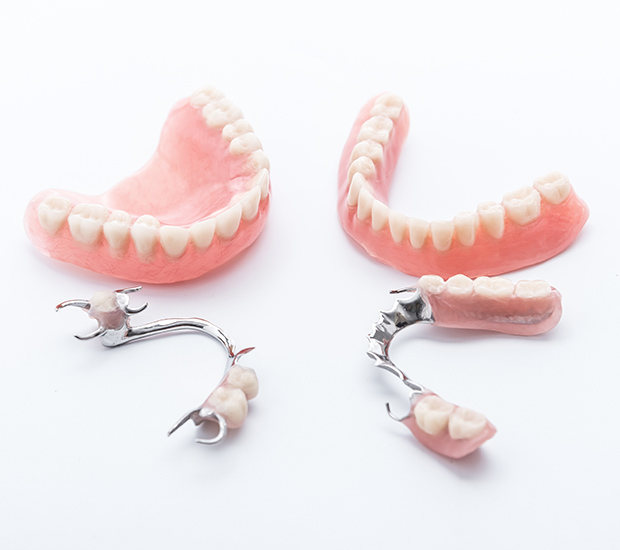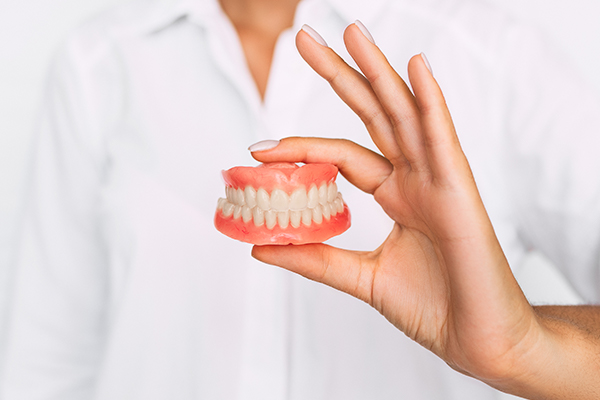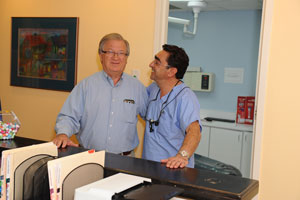Dentures and Partial Dentures Hollywood, CA
Dentures and partial dentures are most commonly associated with seniors, but many young people wear them too. According to the CDC, adult tooth loss has been on the decline for roughly 70 years. Even so, many Americans rely on dentures to improve not just their smiles but also their speech and ability to chew food comfortably. Dentures and partial dentures fill any tooth loss gaps with false teeth.
Dentures and partial dentures are available at Vick Kargodorian, DDS in Hollywood and the surrounding area. We offer a range of tooth replacement options.
If you are ready to learn more about the available options, reach out to us by phone at (323) 962-1998.
Benefits of Getting Dentures
It is normal for people to be nervous about getting dentures and partial dentures. Replacing teeth is an essential step in a person's journey to achieve the oral health they want. Dentures are natural-looking. When in place, dentures do not look awkward or clunky. Dentures have strong artificial teeth and allow patients to eat many of their favorite foods. Also, this treatment can last for ten years or more, depending on how well the patient will take care of the dentures.
According to WebMD, wearing dentures can improve a person's smile. No longer does the patient have to hide a toothless smile but can instead open up without feeling embarrassed or ashamed. Showing off one's smile can make it more comfortable to meet new people, speak in public, socialize, and get back activities they once did. Dentures will typically not cost as much as some other treatments. Some insurance plans may even cover some of the costs. If your considering dentures, talk with your insurance provider to see what parts of the cost are covered.
Check out what others are saying about our denture and partial denture services on Yelp: Dentures and Partial Dentures Hollywood
Choosing Dentures for Tooth Replacement
Dentures and partial dentures only represent one of the many options patients can choose from.
When to Get Dentures
Dentures become a viable option almost every time someone loses their teeth. Even the loss of one tooth can result in the use of partial dentures to rectify the problem. If a person decides to get implants or bridges, they may still wear dentures temporarily until this work is completed.
Note that young people lose their teeth too. One of the most common reasons for this is facial trauma, such as a sporting injury, motor vehicle accident, or a bad fall. These instances can lead to not just missing teeth, but also cracking and breaking.
In addition to this, young people may struggle with cavities. In fact, tooth decay affects people of all ages, especially those who love sugary foods and fizzy drinks. People with poor dental hygiene may also suffer more from caries than others.
Another effect of poor dental hygiene is gum disease, which is sometimes known as periodontal disease. This infection of the gums and the material surrounding the teeth may lead to complete tooth loss over time. People who smoke are more likely to suffer from gum disease than others.
Finally, there are several other health conditions and medications that may result in tooth loss. Diabetes, ectodermal dysplasia, rheumatoid arthritis, and gastrointestinal reflux may all increase the likelihood of tooth loss over time.
How Dentures Are Made
Some processes may differ depending on the materials used in making dentures, but it typically advances in the following sequence.
The process starts with taking an impression of the mouth. The dentist then creates a model using dental stone as a cast. The doctor may then ask the patient to try several different sets of sterilized dentures to determine the ideal fit as well as the preferred color and size of the teeth. After these selections, the dentist may then make some adjustments to the cast. Thereafter, it is sent to a dental laboratory for completion.
At the dental lab, technicians may then create a wax version of the gum line. These technicians make the replacement teeth from a material that closely resembles real teeth known as resin. Virtually all labs then seek approval from the patient and dentist before proceeding with the finishing touches.
Following approval, the technician removes the wax and replaces it with acrylic, which looks far more realistic. This process entails boiling to get rid of the wax, drilling holes in the teeth, and then injecting the acrylic. Finally, technicians clean up the teeth and polish the appliance. The entire process may require the patient to visit the dentist’s office four to five times.
Types of Dentures
When patient’s lookup types of dentures, they mostly come across full dentures and partial dentures. However, these are just the tip of the iceberg. Over the past few years, dentists created hybrids with other dental treatments to provide patients with even more options. You may contact one of our Vick Kargodorian, DDS team members to find out which denture is right for you.
1. Full Dentures
Most commonly used by seniors, these dentures replace a complete set of teeth. They sit directly on top of the gums. Some patients are good candidates for immediate placement. In this instance, the dentist places the previously made dentures immediately after the extraction of the teeth. For everyone else, the dentist may recommend waiting eight to 12 weeks after teeth removal.
2. Partial Dentures
When a patient still has teeth to blend in and anchor with the newly created teeth, the dentist may recommend partial dentures. This may require the use of a metal piece to which a pink-colored base is attached. The metal helps to anchor the false teeth to the natural teeth to prevent movement.
When a patient still has teeth to blend in and anchor with the newly created teeth, the dentist may recommend partial dentures. This may require the use of a metal piece to which a pink-colored base is attached. The metal helps to anchor the false teeth to the natural teeth to prevent movement.
3. Implant-Supported Dentures
This method blends dental implants with dentures. Instead of anchoring all the teeth in place individually, the dentist may add several dental implants that hold the full upper and/or lower set in place. Dentists may use this for partial dentures too. These dentures are not removable once in place. Please note that not all patients are good candidates for dental implants.
4. Overdentures or Snap-In Dentures
When patients prefer to retain the ability to remove dentures, but like the stability of implants, they may opt for overdentures. These are handy in instances where a person has no teeth, as the dental implants provide an anchor that the teeth can sit on. For even more excellent stability, patients may opt for snap-in dentures. In this case, the implants have locator receptors, and the dentures have attachments. These work together to snap the dentures into place for a snug fit.
Options Other Than Dentures and Partial Dentures
Dentures have been improved in design for over a hundred years. Today they are a viable option for patients of all ages, whether one tooth needs to be replaced or many. At Vick Kargodorian, DDS, we can advise patients on when this treatment would suit their oral health needs. At our office, we can also advise you on other options for replacing missing teeth. Each type of tooth replacement has distinguishing qualities. There are two primary categories of tooth replacement other than dentures:
- Dental implants. These are artificial teeth similar in look and feel to natural teeth. They have roots made with screws that are inserted into the jaw for stability. Implants are highly durable with the capacity to last a lifetime with proper care.
- Dental bridge. A bridge closes the space left by missing teeth; hence, why they are referred to as “bridges.” Bridges are held in place by either natural teeth or implants with artificial teeth bridging the space and two or more crowns placed over the teeth and connected to an artificial tooth.
Helping Dentures Last With Proper Care
Dentures can work effectively for up to 10 years. This time frame will depend mainly on the person’s commitment and diligence to maintaining the appliance. Just as patients should brush and floss natural teeth, people must do the same with dentures. These habits will help prevent and remove stains from artificial teeth, helping to preserve the color.
Each night, patients should remove the dentures and soak the appliance in a solution that we recommend to help clean the dentures. After every meal, the wearer should take out the dentures and rinse them off. When doing this, the person must be careful not to drop the appliance. It may be helpful to place a towel on the counter or in the sink.
Dentures should allow the person to eat most foods without any issues. However, the patient should be careful about chewing hard items such as candy, nuts, and ice. Sticky foods can also pull the dentures out of the person’s mouth. If the person notices any damage to the base or artificial teeth, they should contact our office right away.
People should not try to fix the dentures without professional assistance. An article on the American Dental Association website offers more information on the subject of maintaining dentures and what to do if the break. In all cases of the dentures sustaining damage, it is crucial to call us for repairs.
Denture Myths Versus Reality
There are many misconceptions about dentures that can stand in the way of people getting the care they need. Learning the facts about some common myths can help patients better understand their options. Talk to our team to get further information and specific advice for your situation.
- Myth #1: Discomfort and irritation is a normal part of having to wear dentures. Today’s techniques allow the creation of dentures that fit well. If you are not comfortable, it is a sign that something is wrong. If this is the case, consult a dentist.
- Myth #2: Getting dentures means not having to return to the dentist again. Even if you no longer have natural teeth, seeing the dentist at least once a year is vital to maintaining oral health. Dentists can identify and treat gum issues and other problems. They can also adjust your dentures and make sure everything is going well.
- Myth #3: Getting dentures means never being able to eat anything besides soft food again. While it can take a little time to adjust to the feel of eating with dentures, many people can enjoy a variety of foods. The dental team can talk to you in further detail about any concerns regarding the potential effect of your diet on your dentures.
Questions Answered on This Page
Q. Are there different types of dentures?
Q. Are there dentures to replace a few of my teeth?
Q. What are the benefits of dentures?
People Also Ask
Q. How do I take care of my dentures?
Q. What do I do if I damage my dentures?
Q. What do I need to know about making adjustments to my dentures?
Definition of Denture Terminology
- Alveolar Bone
- The alveolar bone is the bone surrounding the root of the tooth that keeps the tooth in place.
- Clasp
- A clasp is a device that holds a removable partial denture prosthesis to the teeth.
- Denture Base
- The denture base is the part of the denture that connects the artificial teeth with the soft tissue of the gums.
- Edentulous
- Edentulous is a term that applies to people who do not have any teeth.
- Periodontal Disease
- Periodontal disease is a condition that causes inflammation of the gingival tissues and membrane of the teeth, leading to tooth loss without professional treatment.
- Pontic
- Pontic is another term for an artificial tooth on a fixed partial denture.
- Rebase
- Rebase is the process of refitting denture prosthesis by replacing the base material.
- Reline
- Reline is when a professional resurfaces the surface of the prosthesis with a new base material.
- Resin/Acrylic
- Resin and Acrylic are resinous materials that can be components in a denture base.
- Stomatitis
- Stomatitis is the inflammation of the tissue that is underlying a denture that does not fit properly. It can also result from other oral health factors.
Back to top of Artificial Teeth






